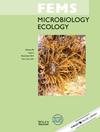Faecal bacterial communities differ amongst discrete foraging populations of dugongs along the east Australian coast.
IF 3.5
3区 生物学
Q2 MICROBIOLOGY
引用次数: 0
Abstract
Gut bacterial communities play a vital role in a host's digestion, fermentation of complex carbohydrates, absorption of nutrients and energy harvest/storage. Dugongs are obligate seagrass grazers with an expanded hindgut and associated microbiome. Here, we characterised and compared the faecal bacterial communities of dugongs from genetically distinct populations along the east coast of Australia, between subtropical Moreton Bay and tropical Cleveland Bay. Amplicon sequencing of fresh dugong faecal samples (n=47) revealed Firmicutes (62%) dominating the faecal bacterial communities across all populations. Several bacterial genera (Bacteroides, Clostridium sensu stricto 1, Blautia and Polaribacter) were detected in samples from all locations, suggesting their importance in seagrass digestion. Principal coordinate analysis showed the three southern-most dugong populations having different faecal bacterial community compositions from northern populations. The relative abundances of the genera Clostridium sensu stricto 13 and dgA-11 gut group were higher, but Bacteroides was lower, in the southern dugong populations, compared to the northern populations, suggesting potential adaptive changes associated with location. This study contributes to our knowledge of the faecal bacterial communities of dugongs inhabiting Australian coastal waters. Future studies of diet selection in relation to seagrass availability throughout the dugong's range will help to advance our understanding of the roles that seagrass species may play in affecting the dugong's faecal bacterial community composition.澳大利亚东海岸儒艮离散觅食种群之间的粪便细菌群落存在差异。
肠道细菌群落在宿主的消化、复杂碳水化合物的发酵、营养吸收和能量收获/储存方面发挥着至关重要的作用。儒艮是一种强制性的海草食草动物,其后肠和相关的微生物群都很发达。在这里,我们对澳大利亚东海岸亚热带莫尔顿湾和热带克利夫兰湾之间不同基因种群的儒艮粪便细菌群落进行了描述和比较。新鲜儒艮粪便样本(样本数=47)的扩增子测序显示,在所有种群的粪便细菌群落中,固着菌(62%)占主导地位。在所有地点的样本中都检测到了几个细菌属(Bacteroides、Clostridium sensu stricto 1、Blautia 和 Polaribacter),表明它们在海草消化中的重要性。主坐标分析表明,最南端的三个儒艮种群的粪便细菌群落组成与北部种群不同。与北部种群相比,南部儒艮种群中严格意义上的梭状芽孢杆菌属 13 和 dgA-11 肠道群的相对丰度较高,而乳杆菌属则较低,这表明儒艮的适应性可能与地点有关。这项研究有助于我们了解栖息在澳大利亚沿海水域的儒艮粪便细菌群落。未来对儒艮整个分布区内与海草可用性有关的饮食选择的研究,将有助于加深我们对海草物种在影响儒艮粪便细菌群落组成方面可能发挥的作用的理解。
本文章由计算机程序翻译,如有差异,请以英文原文为准。
求助全文
约1分钟内获得全文
求助全文
来源期刊

FEMS microbiology ecology
生物-微生物学
CiteScore
7.50
自引率
2.40%
发文量
132
审稿时长
3 months
期刊介绍:
FEMS Microbiology Ecology aims to ensure efficient publication of high-quality papers that are original and provide a significant contribution to the understanding of microbial ecology. The journal contains Research Articles and MiniReviews on fundamental aspects of the ecology of microorganisms in natural soil, aquatic and atmospheric habitats, including extreme environments, and in artificial or managed environments. Research papers on pure cultures and in the areas of plant pathology and medical, food or veterinary microbiology will be published where they provide valuable generic information on microbial ecology. Papers can deal with culturable and non-culturable forms of any type of microorganism: bacteria, archaea, filamentous fungi, yeasts, protozoa, cyanobacteria, algae or viruses. In addition, the journal will publish Perspectives, Current Opinion and Controversy Articles, Commentaries and Letters to the Editor on topical issues in microbial ecology.
- Application of ecological theory to microbial ecology
- Interactions and signalling between microorganisms and with plants and animals
- Interactions between microorganisms and their physicochemical enviornment
- Microbial aspects of biogeochemical cycles and processes
- Microbial community ecology
- Phylogenetic and functional diversity of microbial communities
- Evolutionary biology of microorganisms
文献相关原料
| 公司名称 | 产品信息 | 采购帮参考价格 |
|---|
 求助内容:
求助内容: 应助结果提醒方式:
应助结果提醒方式:


